Watchtower at the Iron Bottom Channel
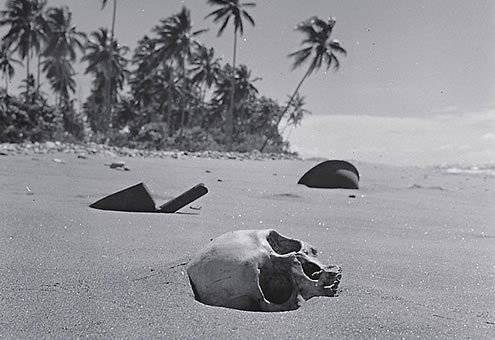
When at the headquarters of the American Pacific fleet in Pearl Harbor late at night decrypted the telegram of General Alexander Vandegrift, then they were confused. He asked urgently to send 14400 condoms! How was this to be understood?
The 1 Division of the Marine Corps, commanded by the general, as part of Operation Watchtower (“Watchtower”) landed on August 7 1942 on Guadalcanal Island and led fierce battles with the Japanese to hold the bridgehead. Why did you need contraception, and even in such significant quantities? After all, the Marines were clearly not in the mood for love, and the local indigenous ladies could hardly have a desire to establish romantic relations with the soldiers, who were under enemy fire every night. It can be seen that Vandegrift encrypted the telegram with a special code unknown to ordinary staff officers. Therefore, they decided to wake Admiral Chester Nimitz, who commanded the fleet and the United States Armed Forces in the Pacific.
Having run through the sleepy eyes of the dispatch, he immediately "decoded" her: "General Vandegrift is going to put condoms on the rifle barrels of the marines to protect them from rain and dirt." Casket, it turns out, opened simply! Chester Nimitz himself began his officer career in the Pacific tropics and had an idea of those places.
GREEN HELL OF KING SOLOMON
Virtually none of the American Marines, and other citizens of the United States, until 1942, did not know what kind of island this Guadalcanal was. It can still be found only on the detailed map of the south-western Pacific Ocean. It belongs to the Solomon Islands, which stretch for 600 miles in two parallel columns from the Bismarck Archipelago in the north-west of Melanesia to the southeast.
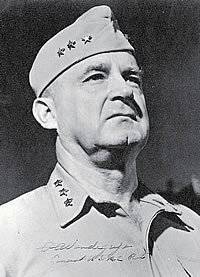 General Alexander Vandegrift. Photo 1945
General Alexander Vandegrift. Photo 1945The honor of their discovery belongs to the conquistadors Don Alvaro Mendanya - nephew of the Viceroy of Peru. The Spaniards were looking for gold over the seas and in search of it in February 1568 reached the unknown archipelago, where they traded a few grains of gold from the local natives. In order to justify the expedition, they christened the island of Solomon, hinting at their infinite wealth, which was not there. One of Don Alvaro’s associates, Pedro de Ortega, surveying the surrounding waters on the Santiago sailboat, stumbled upon a rather large mountainous island (approximately 150 on 48 km), which he named Guadalcanal, in honor of his native city in Valencia. By 1942, as noted by American naval historian Samuel Morison, he "was inhabited by several thousand curly Melanesians and had no other natural riches than dirt, coconuts and anopheles mosquitoes."
From the sea, Guadalcanal, like all tropical islands, looks attractive. It is covered with high green forests alternating with emerald lawns. But this landscape is deceptive. The local jungles are called “rain”, because the trees, enveloped in vines, evaporate a huge amount of moisture, which is constantly dripping in fine droplets from above. Frequent on the island and real rain showers. Therefore, the soil is everywhere damp, swampy. The air is hot, saturated with sourish evaporation, and it seems that it is about to suffocate. At the top in the treetops exotic birds of paradise are singing. Downstairs, there are rats, snakes, huge ants, whose bite is comparable to the touch of a burning cigarette, seven centimeters wasps and, finally, a special kind of leeches that live on trees and attack their victims "from the air." Well, and in numerous small rivers crocodiles are found in abundance. By the way, “emerald lawns” are actually overgrown with kunai grass with sawtooth stiff and razor-sharp stems reaching a height of two meters. One walk through this "green hell" is enough to cripple, catch malaria, tropical fever or a rarer, but no less dangerous disease.
So why did the Americans climb on this god-forgotten island, even if any exact maps of which did not exist? Planning an offensive in the Pacific, they initially did not intend to take Guadalcanal. They, in general, had little strength, since in coordination with London, Washington concentrated the main army units for a landing in North Africa (Operation Torch — Torch). The American command, together with the allies (Australia, New Zealand and Great Britain), was going to recapture only the small Tulagi island located 20 miles west of Guadalcanal (5,5 on 1 km), which was part of the Japanese 1942 in May. The British administration was located there before, since the climate on the island was much more comfortable than on Guadalcanal. However, this is not the point. Next to Tulagi, on the tiny islands of Gavutu and Tanambogo, the Japanese launched a hydroaviation base, which worried the Allies, since the aircraft that started following the sea links connecting the USA with New Zealand and Australia started from it.
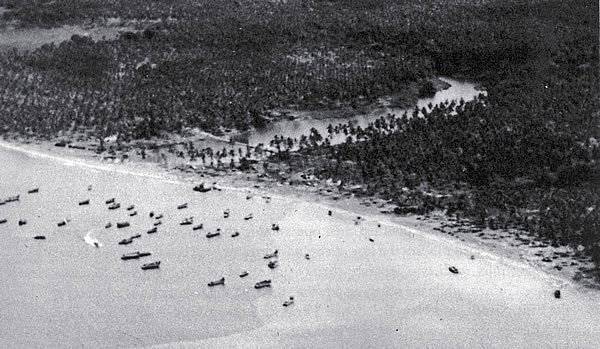
But at the end of June, the coastal observers, as the secret allies intelligence officers called, reported that the Japanese in the area of Cape Lung on Guadalcanal began building a large airfield. 4 July aerial reconfirmation confirmed this information. It changed the picture. From the airfield, the Japanese were able to attack convoys on their way to Australia. And Guadalcanal itself turned into a base, relying on which the imperial army and navy could develop an offensive on the islands of Espiritu Santo and New Caledonia with the further deployment of attacks on New Zealand.
The Marine Corps was tasked to seize the airfield in order to use it further against the Japanese, and at the same time to take Tulagi with Gavutu and Tanambogo under complete control.
The 75 warships, including the 3 aircraft carrier, the battleship, the 6 cruisers, and paratroopers from the USA, Australia and New Zealand, were attracted to the Watchtower operation. The backbone of these forces were the US Navy and US Marines. 26 July in the Fiji Allies conducted exercises. They showed the unwillingness of the invading forces. Amphibious scuttles almost killed on the reefs. Nevertheless, they decided to carry out the operation. The command of the expeditionary forces was entrusted to Vice-Admiral Frank Fletcher, who had already twice led 1942 in strategic battles of the American fleet in the Pacific: in the Coral Sea and Midway Atoll. True, in both cases, the ships on which Fletcher (the aircraft carriers Lexington and Yorktown) held their flag went to the bottom. But the battlefield, as they say, is left for the Americans. Particularly convincing was the victory of Midway (for more, see the magazine “National Defense” №5 / 2012). Amphibious forces were led by Rear Admiral Richmond Turner, and Major General Alexander Vandegrift was headed by the 1 Division of the US Marine Corps, numbering about 16000 people.
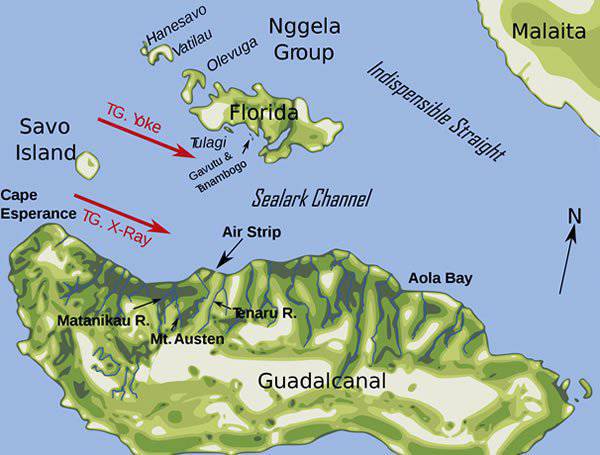
SUCCESS WITH CATASTROPHIC FINAL
Frankly speaking, the allies were very lucky. During the movement of their armada to Guadalcanal low clouds hung, and the ocean was often covered with fogs. Japanese reconnaissance aircraft did not see the enemy. Thus, the Americans and their partners managed to get to the landing site unnoticed, which passed without a hitch, since, fortunately, there were no insidious coral reefs at Cape Lung. And, in fact, there was no resistance by the enemy. Of the 2800 people, the Japanese contingent 2200 was the builders, and for the most part Korean subservient, who were not eager to shed blood for the Land of the Rising Sun. They threw the object, leaving it with equipment, building materials and food. Already on the second day, the airfield was in the hands of the Marines. He was named Henderson-Field in honor of the Marine Corps pilot Lofton Henderson, who died in the battle for Midway, the first to attack Japanese aircraft approaching the atoll.
The situation was more complicated in Tulagi, Gavutu and Tanambogo, where three thousand American marines met the desperate resistance of the enemy’s small garrison. But supported by the aircraft carrier aviation and ship artillery by August 9, the Americans still prevailed, losing 122 people killed. Of the 886 subjects of the emperor, almost all died.
However, the Japanese sought revenge. Already 7 August, their aircraft from the base in Rabaul, on the island of New Britain, strongly attacked the Allied expeditionary forces. As a result of the raids, the transport of George F. Elliot was set on fire, which sank later, and the destroyer Jarvis was badly damaged. It is impossible not to pay tribute to the training and courage of the Japanese pilots. From Rabaul to Guadalcanal - 640 miles, which is almost at the limit of the radius of flight of Zero fighters. But they still found the opportunity to fight with American aircraft. Pilot Saburo Sakai, who had already won 56 victories, shot down an F4F Wildcat fighter and a SBD dive bomber over Guadalcanal. He rushed to the whole group of Avenger attack aircraft. But he could not cope with them. His Zero flashed several machine gun bursts. The pilot lost his right eye and was wounded in the left. His left body was paralyzed. But he brought his plane to Rabaul and successfully landed, having spent eight and a half hours in the air!
In the morning, 7 August 5 heavy, 2 light cruisers and destroyer of the Imperial fleet under the command of Vice Admiral Guniti Mikawa from the bases on Rabaul and Kavieng headed south-east to Guadalcanal along the strait separating the eastern chain of Solomon islands off the island. The Americans called this strait Slot (Slot), that is, the "Slit". And from this Slit the Japanese then regularly inflicted cruel blows on the Allies.
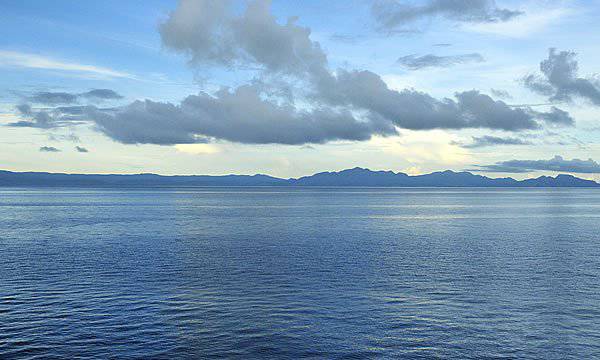
A little earlier, Mikawa’s connections to Guadalcanal went to 6 Japanese transports with troops. But they did not have time to go to sea, as one ship was sunk by the torpedoes of the American submarine S-38. Along with the steamer displacement 5600, 14 officers and 328 soldiers died. Fearing new attacks from under the water, the remaining transports hurried to return to Rabaul.
Around 300 miles from Guadalcanal on August 8, on 10 hours of 28 minutes, the Mikawa connection was detected by an Australian patrol plane. But the pilot, instead of urgently reporting on contact with the enemy, decided not to violate the radio silence mode. And only in the late afternoon, this crucial information reached Brisbane (Australia), where General Douglas MacArthur's headquarters were located, and from there it was redirected to Admiral Richmond Turner, who received it at 18.45. That is, it took more than 8 hours to bring the intelligence to the consumer, who was very close and who urgently needed information about the coordinates of the approaching enemy. This is what the absence of a developed network-centric system meant!
Turner immediately convened a meeting at which it was decided to withdraw 9 August allied transports from Guadalcanal, despite the fact that a significant portion of the ammunition and equipment for the marines remained unloaded. This move was motivated by the fact that by that time Admiral Fletcher had withdrawn his aircraft carriers from the island, citing the need to refuel the escort destroyers with fuel and significant fighter losses (78 from 99 remained). As Turner said later, the departure of the Fletcher aircraft carriers "left him completely naked." But the commander of the amphibious forces still had hope that the enemy would attack only the next day.
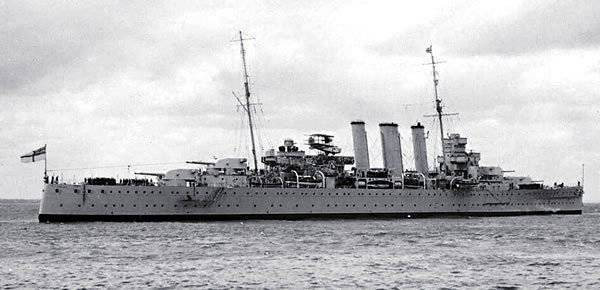
But he did not wait. The tragedy happened after midnight on August 9. The Allied cover group under the command of Australian Rear Admiral Viktor Kratchli divided their forces. Part of the ships in the Canberra and Chicago heavy cruisers, the destroyers Patterson and Bagley carried a patrol at the southern tip of the small island of Savo, which is about halfway between Guadalcanal and Florida. From the north of this island, cruisers Vincennes, Astoria and Quincy, as well as destroyers Helm and Wilson, patrolled. Destroyers Ralph Talbot and Blue were sent up the Slots, designed to carry out early radar detection of the enemy.
It would seem that the Americans and their allies had the advantage for the night battle, because they had, though not very perfect, radars, and the Japanese did not. However, the battle near Savo Island was not formed according to the American scenario.
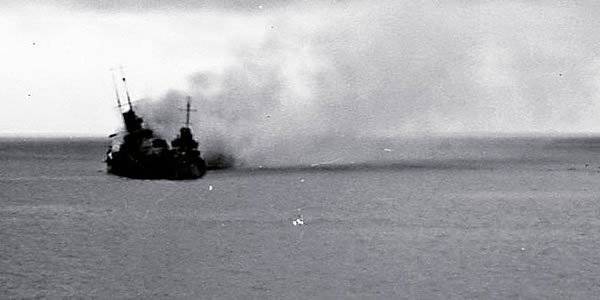
Admiral Mikawa set the task for the commanders of his ships: approach Guadalcanal, sink the enemy’s transports and retreat as far as possible to avoid being hit by bombs and torpedoes of American aircraft carriers in the morning (if he only knew that they had left!). In 00.54 from the bridge of the Japanese flagship cruiser Chokai, found an American ship. It was a sentinel Blue destroyer. But they did not notice the enemy, who was safely left behind astern.
Soon the Japanese met the Allies' southern group of ships. She was weakened, as Admiral Kratchli departed for a meeting with Turner on his flagship - the cruiser Australia, and he had not yet had time to return. The Allies again did not notice the Japanese. Meanwhile, Admiral Mikawa gave the order: “Everyone attack! Shoot it yourself! ”A hail of shells fell, and torpedoes ripped up the water. Two of them hit the side of the Australian cruiser Canberra, and the shells began to crush its superstructure. Soon the ship lost speed and began to draw water. The American Chicago cruiser had a torpedo explosion tearing off part of the nose, and it was enveloped in a fire flame.
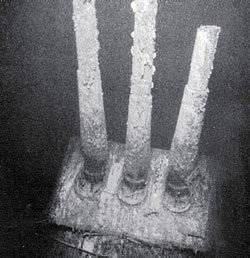 The tower of the main caliber of the American heavy cruiser Quincy is today a “tourist site” for diving enthusiasts.
The tower of the main caliber of the American heavy cruiser Quincy is today a “tourist site” for diving enthusiasts.In six minutes, the Japanese finished with the southern formation, and then, rounding the island of Savo, headed for the northeast, where they caught up with the northern group of the enemy. The second squad began, which ended with the sinking of the American cruisers Vincennes, Astoria and Quincy. As a result of the battle, the Allies lost 1077 people killed, 4 cruisers (Canberra sank the next morning). The Chicago cruiser and the destroyer Ralph Talbot suffered heavy damage. “It was one of the worst defeats the US Navy ever suffered,” Samuel Morison notes. After the tragedy played out in the Savo Strait, the Allies renamed it the Iron Bottom Strait. And this water area has repeatedly confirmed the sad accuracy of the name given to it. During the six months of the battle for Guadalcanal, the 34 ship, the Allied ship and boat, and also the 14 units of the Imperial Fleet found their last refuge at its bottom. Even these waters could be called Shark Maw, as predatory fish, smelling the smell of blood, gathered there, it seemed, from all over the southwestern Pacific. Many sailors became victims of these voracious creatures.
Why did the battle turn into a fiasco for the US Navy? Firstly, the Japanese sailors' training turned out to be higher than the American ones. They were very good at night fighting. Secondly, the Allied ships did not establish a reliable connection between them. In the northern union they did not even know that the southern one was already fighting. Thirdly, the control of the forces of the allies was put very badly. Fourth, Japanese sailors had great night-time binoculars, which the Americans and Australians did not have. Finally, in their hands was powerful weapon - heavy 610-mm torpedoes of the 093 type, which had a mass of 490 warheads of kg and effective range of 22 km at 48-50 units speed. Americans called them Long Lance, that is, "Long Spear." A single hit of such a torpedo was enough to, if not sink, then disable the heavy cruiser of the enemy.
But the Japanese, who were slightly damaged flagship cruiser and destroyer, did not perform the main task. Admiral Mikawa, fearing a raid by American aircraft from aircraft carriers, refused to attack the still-unloading transports. Only in the evening of August 9, Admiral Turner withdrew from Guadalcanal with his ships. As if in retaliation for this misstep, the American submarine S-44 attacked the returning Japanese ships and sank the cruiser Kako.
"TOKY EXPRESSES" RUN FOR THE CUT
The so-called "sea bees" (Seabees), that is, the engineering units of the US Navy, immediately engaged in the completion of the airfield, and the marines wisely bothered to strengthen the perimeter of its defense. The Japanese troops on the island soon came to their senses from the shock caused by the sudden attack of the Americans, and made themselves felt. On August 12, a Marine patrol stumbled into an ambush and was killed. In response, three companies of the Marines attacked the villages of Matanikau and Kokumbona, where the enemy settled. 65 Japanese soldiers were killed, the Americans lost four of their comrades.
And August 18 Henderson Field was already ready to receive and produce aircraft. On August 20, the Long Island escort aircraft carrier approached Guadalcanal, delivering F19F Wildcat and 4 SBD Dauntless Marine Corps dive planes to 12 fighters. Two days later, arrived four army fighter P-39 Airacobra. From that moment on, the aviation group began to operate, which called itself “Cactus” (Cactus Air Force - CAF). For another six months, the Japanese fought fiercely on land, in the air and on the sea to break off these "cacti".
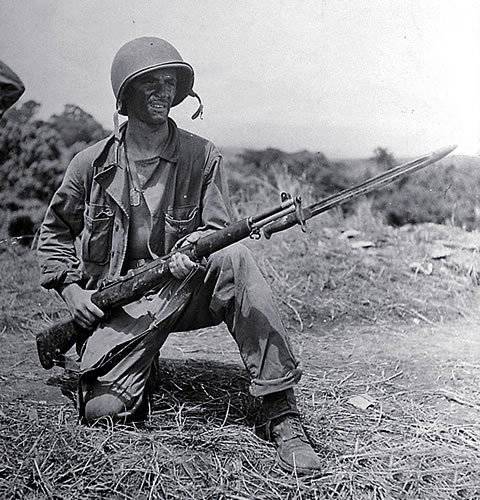
Not having superiority in the air, they were wisely afraid to send low-speed transports with troops to Guadalcanal, although dry cargo ships were also used to deliver heavy equipment and artillery. For the transfer of military units, ammunition and food to the island were used, mainly by the figurative definition of the Americans, "Tokyo Express" - high-speed destroyers, who first brought troops and equipment, and then also fired Henderson Field and his defenders.
19 August from the six destroyers in 35 km east of Cape Lung, the Japanese landed 916 soldiers from the 28 Infantry Regiment under the command of Colonel Kienao Ichiki. This officer clearly underestimated the forces of the enemy. Early in the morning he left his subordinates on the perimeter of the defense of the American marines. The Japanese launched a frontal attack. Most of them died, including Colonel Ichiki. 128 people survived. But they did not surrender, but, to the joy of the Yankees, who had nothing to feed them, they preferred to die from wounds, hunger and diseases in the thicket of the "green hell."
Before 4 September, the Japanese transferred 5000 servicemen to Tokyo’s express trains on Guadalcanal. They were led by Major General Kietake Kawaguchi. On September 14, the Japanese launched an attack on Henderson Field through a mountain range that hung over the airfield, but were beaten off with heavy losses. It was the first defeat of a large division of the Imperial Army since the start of the war in Asia and the Pacific. In Tokyo, they realized that on a distant island, not tactical battles take place, but more serious events. At a meeting of the General Staff in Tokyo, it was stated that "Guadalcanal may have turned into a general battle of the war." So it was.
The situation was aggravated not only on the island, but also in the waters washing the Solomon Islands. 24 August clashed American and Japanese aircraft carriers. The first were the dive bombers of the aircraft carrier Saratoga, which hit the Japanese light aircraft carrier Ryujo with ten bombs. The ship caught fire and sank. But the Japanese did not remain in debt. Several Japanese aircraft broke through the curtain of fighters and drove three bombs into the deck of the aircraft carrier Enterprise. Perfectly delivered survivability service saved the ship from destruction. However, he was forced to hastily retreat and go for repairs.
The next day, the “cacti” with Henderson Field made contact with the Japanese light cruiser Jintsu and transport with troops moving towards Guadalcanal. The damaged cruiser was gone, but the transport had lost its course. The destroyer Mutsuki approached its board in order to remove the landing force and the crew from the sinking ship. And here for the first time in the war at sea, the American heavy bombers B-17, which had risen from Espiritu Santo Island, achieved success. Three of their bombs smashed the ship under the flag of the Land of the Rising Sun to pieces.
The battle of the Eastern Solomon Islands was victorious for the Allies, although the results, at first glance, seemed modest. But do not forget that the Japanese then refused to land a large landing on Guadalcanal.
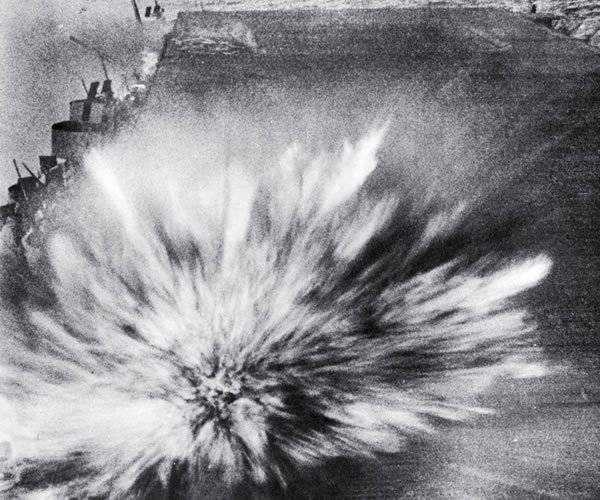
The author of the picture - Robert Reed - died at the same second when he pressed the shutter button of his device.
Alas, military fortune is changeable. On September 15, to the south of this island, the Japanese submarine I-19 sank the American aircraft carrier Wasp, accompanying the Allied convoy to Guadalcanal. This complicated the situation of defending Henderson Field. The fact is that the damaged aircraft carriers Saratoga and Enterprise were repaired. At the disposal of the US Navy in the South Pacific was one aircraft carrier Hornet, while the Japanese had several ships of this class.
And the Japanese continued to drive "Tokyo express trains" to the island. It happened that during the night they managed to land up to 900 people. The night-time shelling of Henderson Field by the artillery of the Japanese ships continued. In order to stop these attacks, the American command sent a detachment of ships under the command of Rear Admiral Norman Scott to intercept a large "Tokyo express train". In addition, this compound was supposed to cover the Allied convoy transporting troops and equipment to Guadalcanal. On the night of 11 on October 12, a battle took place near Cape Esperance - at the northern tip of the island. After the victory at Savo Island, the Japanese did not expect serious opposition. And miscalculated.
In 22.32, the radars of the ships of the American squad discovered the enemy. The 23.46 cruisers Helena, Salt Lake City, Boise and the destroyers opened fire. The heavy cruiser Aoba, who was leading the Japanese detachment under the flag of Rear Admiral Aritomo Goto, was struck by their first volley. His bridge was demolished. Admiral Goto was killed. The destroyer Fubuki, who once opened a series of magnificent ships of this class, went to the bottom. The heavy cruiser Furutaka also went there. Some more ships were damaged. There were no casualties on the American side. The destroyer Duncan, who turned out to be on the line of fire of his own and other ships, received several holes and sank. And when it dawned, diving bombers from Henderson Field sank the Japanese destroyers Natsugumo and Murakumo, who returned to the battlefield to raise their dying comrades from the water.
Pearl Harbor and Washington were jubilant. Here it is worthy of revenge for the defeat of the island of Savo. This is not just the defeat of the next "Tokyo Express", believed in the American headquarters, but a turning point in the fighting for Guadalcanal. But the euphoria was premature. On October 14, the Kongo and Haruna battleships approached Guadalcanal. With their 356-mm shells, they literally plowed Cactus runways. 41 American died from Japanese fire. The 48 90 aircraft that were available were destroyed, and the survivors were damaged and in need of repair. Almost all aviation gas reserves burned. Henderson Field seemed to be ending.
But by that time, the Seabees had learned so quickly to restore the runways that it took them only a few hours to revive the Cactus. In general, specialists in the fleet's engineering and construction units, heading for Guadalcanal, were selected to do all-rounders. They could not only quickly patch up the airfield and its facilities, but also repair the planes themselves. And when the situation required, "sea bees" took up rifles in their hands and replaced the artillerymen who had left in battle.
GOSP FROM "BULL" HELSEY
This craft would soon come in handy. By October 17, the Japanese military contingent on Guadalcanal had already reached almost 20000 people. Therefore, it was decided to attack the positions of the Americans, and from the new direction - from the south. For the main attack on Henderson Field, the 2 Division was assigned under the command of Lieutenant General Masao Maruyama, numbering 7000 soldiers. Another 2900 man under the command of Major General Tadashi Sumiesi, as well as heavy artillery, had to attack the perimeter of the defense of the airfield from the west, in order to divert the attention of Americans from the direction of the main attack.
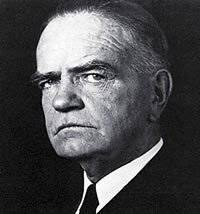 Admiral William "Bull" Halsey.
Admiral William "Bull" Halsey.It should be noted that the Americans did not find the enemy approaching. Therefore, the Japanese strike on the night of 23 on October 24 was unexpected for them. However, due to inconsistencies, the Western grouping of the Japanese launched an offensive earlier than the main forces of General Maruyama approached. And when they launched the attack, parts of General Sumiesi were already swept away and broken with heavy losses. To reflect the main attack of the enemy, units of the 7 regiment of the marines and the newly arrived 164 regiment were involved. Gun gunshot and rifle-machine-gun fire managed to stop the enemy. However, several groups of Japanese soldiers leaked through the perimeter of the Henderson Field defense, and they even reported that they had captured the airfield. But soon they were all destroyed. Repeated attacks Maruyama also failed. In the end, the Japanese were forced to withdraw their parts from the "Cactus", losing about 3000 killed. The Americans said farewell to 80 by their compatriots.
At the time the enemy attacked Henderson Field, General Vandegrift was not on Guadalcanal. He was located in Noumea on the island of New Caledonia, where the headquarters of the commander of the forces of the South Pacific Ocean was located, under the operational control of which were the islands occupied by the marines. A commander change has just taken place. Admiral Chester Nimitz decided to change in this post his old friend, Vice Admiral Robert L. Gormley, who, apparently, lost faith in the ability of the Americans to keep Guadalcanal. Instead, he was appointed Admiral William Halsey, for the stubborn, indomitable and furious character awarded by co-workers the nickname "Bull" (Bull). Having taken up the position, he at once briefly and clearly formulated the task facing the troops and fleet: “Kill the Japs! Kill the Japs! Kill more Japs! ”This appeal was enthusiastically received on ships and in military units. "Yes, we were not civilized, not knightly war," said Samuel Morison. “We applauded when the Japs died.” We are back to the days of the war with the Indians. The Japs have gone this way, thinking that they will intimidate us as a "decadent democracy." And they got the war they wanted, but with all the horrors that modern science could give. ”
At a meeting in Noumea, Halsey asked Vandegrift if he could keep Henderson Field. He answered in the affirmative, but asked for more active support of the fleet. “I will do everything I can,” promised the Bull shortly. The case was not slow to confirm his words.
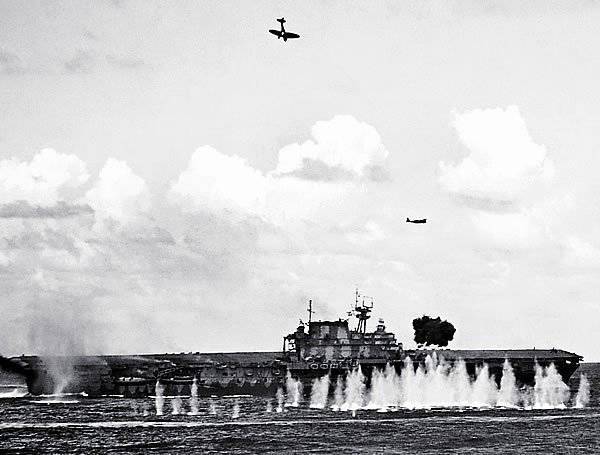
October 26 07.17 reconnaissance aircraft taking off from the deck of the aircraft carrier Enterprise, located in the area of the Santa Cruz Islands, which is southeast of Guadalcanal, discovered a Japanese attack connection consisting of several aircraft carriers, battleships, heavy cruisers and many destroyers. This armada was moving toward Guadalcanal. In 8.30, the first attacking group was raised from the Hornet aircraft carrier. Then followed a wave with Enterprise. American aircraft drove four 1000-pound bombs into the Japanese aircraft carrier Shokaku. He left the battlefield, but did not sink. Japanese counter-attacks proved to be more effective. They hit four bombs and two torpedoes in the Hornet. Then two more bombs and a torpedo. Two wounded burning enemy bomber crashed into its deck. The hero ship of the first American airstrike on Tokyo (see National Defense magazine # XXUMX / 3) was doomed. Got and Enterprise. He received two Japanese bombs.
The first battle of the "Bull" Halsey as the commander of the forces of the South Pacific was lost. True, the Japanese lost about a hundred aircraft, as well as a large number of well-trained pilots. In addition, the Japanese abandoned their intention to deliver a powerful blow to Henderson Field.
FRIDAY 13-GO, OR WHEN LINCOR IN A SEA OF WARRIORS
The Americans did not promise anything good and the beginning of a new naval battle at Guadalcanal. To replenish their contingent on the island and deliver heavy weapons, the Japanese equipped 12 large transport ships in early November. For their support, the battleships Hiei and Kirishima, the cruiser and 15 destroyers, which were to wipe Henderson Field from the face of the earth, were set off. The operation was commanded by Vice-Admiral Hiroaki Abe.
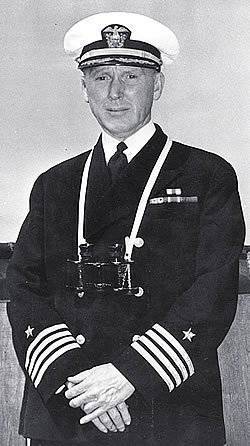 Admiral Norman Scott won the battle at Cape Esperance, but was killed in the 13 battle in November 1942.
Admiral Norman Scott won the battle at Cape Esperance, but was killed in the 13 battle in November 1942.To intercept the enemy, the Americans sent two operational connections, commanded by Rear Admirals Daniel Callaghan and Norman Scott. At their disposal were two heavy and three light cruisers and eight destroyers. After midnight on November 13, on Friday, the battle began. And again, the Japanese demonstrated their ability to fight in the conditions of "even put out the eye." American forces mixed up and lost control. The situation that happened on August 9 in the Battle of Savo Island was repeated. American cruisers Juneau, Atlanta, Helena and four squadron destroyers found their doom in the Iron Bottom Strait. The cruisers of Portland, San Francisco and three destroyers were heavily damaged. Admiral Norman Scott, who was famous for his victory at Cape Esperance, was killed. However, in three months the Americans learned something. They focused fire on the battleship Hiei. He got 85 hits with artillery shells and began to sink. Two Japanese destroyers went to the bottom. In the morning, the Cactus attack aircraft finished off the enemy battleship, which sank. Admiral Abe had to retreat.
But the Americans have become desperate. Henderson Field hid from the sea almost exclusively with torpedo boats. On the night of November 14, the Japanese heavy cruiser Takao and the destroyer fired on the airfield without hindrance. And only the intrusive attacks of torpedo boats, although not effective, forced them to move away.
"Bull" Halsey wanted to stop the strike on the island no matter what. He ordered the high-speed battleships of Washington, South Dakota and the four destroyers of the Enterprise aircraft carrier escort on full pairs to rush to Guadalcanal. This compound was commanded by Rear-Admiral Willis Lee, an ethnic Chinese, winner of seven 1920 Olympic medals for rifle shooting, including five gold ones, and a hot radar enthusiast.
In the afternoon of November 14, Enterprise and Cactus dive-bombers and torpedo bombers attacked Japanese transports approaching the island. They drowned or set fire to 8 of them. The remaining four threw themselves on the rocks at Cape Tassafarong to try to unload.

To protect them, hastened the Japanese ships. At midnight on 15 November they were discovered by the radar battleship Washington. In order to better assess the situation, Admiral Lee took the place next to the radar operator. An artillery duel ensued. The Japanese concentrated fire on South Dakota and caused serious damage to this battleship. And with “long spears” they got American destroyers, three of which sank. The Dreadnought Washington was left virtually alone, since the fourth Gwin destroyer was damaged. But the skillful possession of the radar by Admiral Lee brought the Americans to winners in the battle of Guadalcanal. Nine 406-mm and forty-127-mm Washington shells turned the Japanese battleship Kirishima into a pile of scrap metal, which was absorbed by the waters of Slota. The same morning, American aircraft and artillery collapsed on the emitted transports and destroyed them, along with all the cargo.
This battle was the culmination of the battle for Guadalcanal, but not its final. The Japanese resisted the American onslaught for more than two and a half months. And often not without success.
Supported by the fleet and reinforced by American marines, they no longer confined to the Henderson Field perimeter defense, but began to undertake offensive operations, displacing the enemy into swamps and other areas of the island of little human habitat. "Tokyo Express" continued to supply the troops of the emperor with ammunition and food. But flights became less and less. During naval battles and from air raids, the fleet of the Land of the Rising Sun lost many destroyers. Tortured and torpedo boats, often disrupting the delivery of goods. And there was almost no replenishment of the ship. But the American fleet in the waters washing Guadalcanal grew by leaps and bounds. And, nevertheless, the last sea battle in the Gap was left for the Japanese.
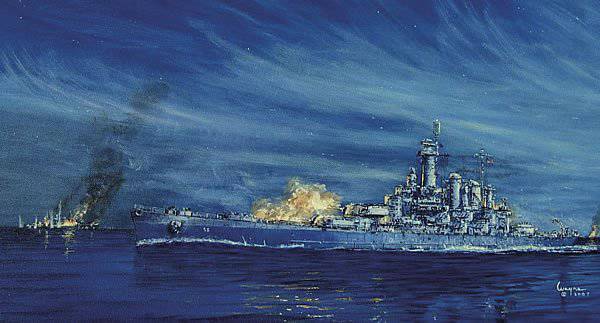
By November 26, some advanced Japanese units had not received food for six days. Given the desperate situation of their warriors, the Japanese command sent the next Tokyo express to Guadalcanal. A detachment of eight destroyers under the command of Rear Admiral Reizo Tanaki headed for Cape Tassafarong, where it was planned to drop containers with food and ammunition. Admiral Halsey sent to intercept the TF67 operational compound of four cruisers and six destroyers under the command of Rear Admiral Carleton Wright. That is, the Americans had absolute superiority. Late in the evening on November 30, the opponents met. The Americans first discovered the enemy, but lingered for four minutes. This time was enough for the Japanese to make an evasive maneuver. When the Americans opened fire and fired torpedoes, the destroyers Tanaka had already left, pre-launching 44 torpedoes in the direction of the Americans. Several of them reached the goal. They sunk the cruiser Northampton and badly damaged the cruisers Minneapolis, New Orleans and Pensacola. The destroyer of Takanami became the only victim of the fire of the American armada. But the Tanaka ships did not fulfill their mission. They did not deliver the goods to the Japanese troops.
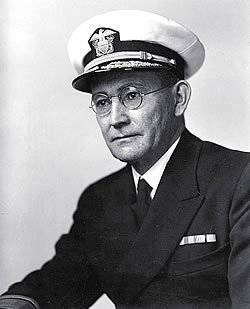 Admiral Willis Lee.
Admiral Willis Lee.After this, the slow agony of the Japanese garrison began. Yes, some ships of the Imperial fleet broke through to Guadalcanal, but they were not able to solve the problem of supplying the contingent exhausted by battles, heavy losses and diseases.
SHINING EVACUATION DURING CIRCULAR DAMAGE
Meanwhile, from the second half of October, the 1 Division of the US Marine Corps was gradually replaced by units of the XIV Corps (it included the 2 Division of the Marine Corps, 25 Division of the American Division) under the command of Army General Alexander Patch. This association in January 1943 numbered more than 50000 people.
And although the Vandegrifta Marines did not spend four weeks on Guadalcanal, as they had expected, but four months, their losses were relatively small. Killed, dead from injuries and missing, they lost 1242 man. But almost everyone suffered from malaria and other diseases. There was no salvation from them. Even Admiral Chester Nimitz during his second two-day trip to the island managed to catch a severe form of malaria.
Already on December 12, the Japanese command began to develop an operation to evacuate Guadalcanal, because this island was literally devouring and grinding troops, ships and aircraft. On December 28 the emperor was informed about this, who approved the decision of his admirals and generals.
The last bloody battle on Guadalcanal took place on 10-23 on January 1943 in the area of Austin Mountain. The Japanese of the last forces resisted, but, having lost about 3000 killed, retreated, trying not to touch the American forces as far as possible.
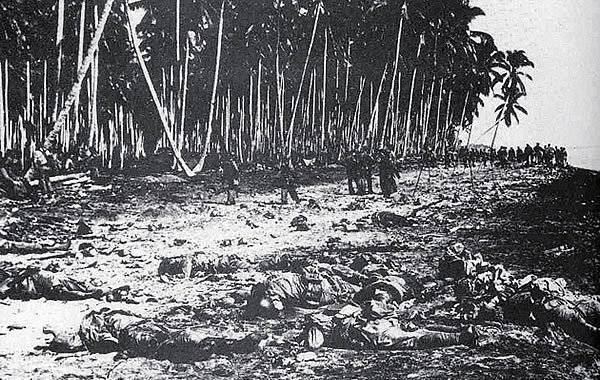
When 9 February 1943 in Noumea and Pearl Harbor received a report from General Patch that his troops could not find the Japanese on the island, they did not believe at first. But it was true. On the night of February 1, 20 destroyers under the command of Admiral Shintaro Hashimoto removed the 4935 soldiers. Then 4 and 7 February was completed evacuation of almost all the remaining troops. In total, 10652 Japanese servicemen escaped from Guadalcanal unnoticed. This operation in its secrecy is still unsurpassed.
But it was an escape, not an offensive. After Guadalcanal, Japan finally lost its strategic initiative in the war in the Pacific. And the United States moved to the strategy of "frog jumping" - the conquest of islands and archipelagoes in the Pacific one after the other. This continued until they reached Japan.
The losses of the imperial army and navy were heavy. 31000 killed, lost 38 warships of main classes and about 800 aircraft. The US also missed 7100 people, 29 ships and 615 aircraft. Comparison of numbers speaks for itself.
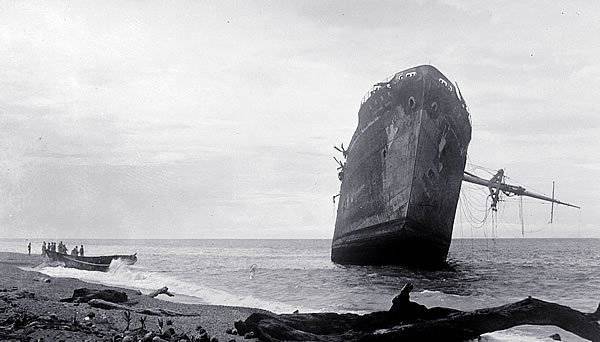
In the battle for Guadalcanal, both sides intensively used all types of armed forces and all types of weapons. All classes of surface ships, submarines, torpedoes and mines, fighters, attack aircraft and strategic bombers took part in the battles, Tanks and field artillery. Technically and tactically, the Americans turned out to be higher in ground operations, but they were clearly inferior to the sea, although there the U.S. Navy fulfilled its mission, preventing the enemy from destroying the Henderson Field airfield, which caused all this bloody mess. In the end, the economic power of the United States prevailed. Their Armed Forces received everything they needed, in the required quantities, at the right time and of sufficiently high quality. American pilots, sailors and soldiers prepared for the upcoming battles properly, which ultimately predetermined the victory of the Allies in the Pacific Ocean.
Information